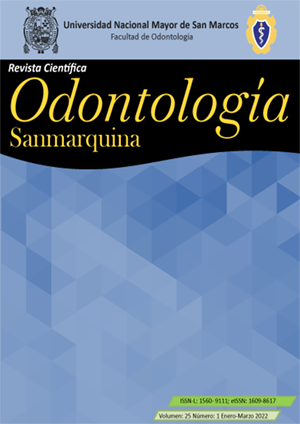Epidemiological profile and presence of IFR6 (rs2235371), TGFA (rs3771494) polymorphisms in individuals with non-syndromic cleft lip and palate
DOI:
https://doi.org/10.15381/os.v25i1.20573Keywords:
Cleft lip, Cleft palate, Polymorphism, Epidemiology, (source: MeSH NLH)Abstract
Objective. To report the epidemiological profile and the presence of polymorphisms of the IFR6 (rs2235371) and TGFA (rs3771494) genes, in individuals with non-syndromic cleft lip and palate. Methods. Case series study, focused on individuals with orofacial clefts, referred to the School of Dentistry of Durango, Mexico, for review and assessment within the period from January 2018 to December 2019. Information of interest for the study was obtained on the characteristics of pregnancy and family history of the mothers of the individuals. For the analysis and description of the data, the statistical software R Studio was used. Results. There was a higher frequency of men (67%), most of the individuals had the diagnosis of cleft lip and palate at birth (75%), the extension of the complete affection (75%), the left side affected (63%), and corrective surgeries (62%). Only 4% were exposed to maternal smoking (active and passive), 96% had adequate folic acid and iron intake; the risk genotype for TGFA (rs3771494 [G/G]) was present in 15% of cleft lip and 8% of cleft lip and palate, and for IFR6 (rs2235371 [T/T]) only in 10% of cleft lip and palate. Conclusions. The presence of environmental and genetic factors, as well as the maternal lifestyle shown in other populations, may not be the same as those involved in the appearance and development of non-syndromic orofacial clefts in our locality, in addition, the presence of homozygous polymorphic genotypes of the genes of interest could not condition the development of orofacial clefts.
Downloads
Downloads
Published
Issue
Section
License
Copyright (c) 2022 Víctor Hiram Barajas-Pérez, Graciela Zambrano-Galván, Oscar Eduardo Almeda-Ojeda, Norith de Jesús Recendez-Santillán, Edgar García-Torres

This work is licensed under a Creative Commons Attribution 4.0 International License.
AUTHORS RETAIN THEIR RIGHTS:
a. Authors retain their trade mark rights and patent, and also on any process or procedure described in the article.
b. Authors retain their right to share, copy, distribute, perform and publicly communicate their article (eg, to place their article in an institutional repository or publish it in a book), with an acknowledgment of its initial publication in the Odontología Sanmarquina.
c. Authors retain theirs right to make a subsequent publication of their work, to use the article or any part thereof (eg a compilation of his papers, lecture notes, thesis, or a book), always indicating the source of publication (the originator of the work, journal, volume, number and date).






